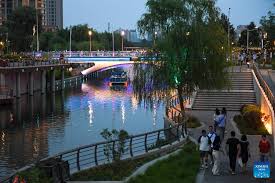Building China-European bridges along the Liangma River

It takes 10 to 11 hours by plane to travel from Beijing to Paris. However, when inviting European friends to the “Seine River” in Beijing, it’s just a matter of a WeChat message. In this video, China Daily reporter Zhao Manfeng invited several European youths to the Liangma River, known as the “Seine River of Beijing,” to cruise along the river. They discussed the connections between China and Europe, as well as the mutual friendship that flows between the Liangma River and the Seine River.
Have you noticed that there is a bridge on the back of every euro banknote? These bridges symbolize Europe’s openness and serve as historical witnesses connecting Europe with other parts of the world.

Although China and Europe are thousands of miles apart, they have been connected since ancient times through the Silk Road, and now, there are more forms of “bridges” that tightly link us together. Today, in fields such as economy, technology, and education, the connections between China and Europe are closer than ever before.
China has granted visa-free entry to multiple European countries, facilitating personnel exchanges and economic and trade activities between the two sides.
Pierrick Bougault, a French student studying at Tsinghua University, said his family is planning to visit him in China this July. Now, without the need for a visa application process, they only need to buy plane tickets and head to the airport to come to China.
Pavle Knezevic, a Serbian living in Beijing, noted that made-in-China products are becoming increasingly popular in Europe. Smartphones, drones, and laptops made in China have brought convenience to the world. He admired the education and dedication of the Chinese people in developing these high-tech industries.
Thalia Ripoll, a French student studying at Peking University, joyfully expressed that while Paris has the Seine River, Beijing has the Liangma River. And they serve as the same purpose: people walking around, doing sports, and meeting friends.
“I personally believe that each foreigner in China is their own bridge, building bridges with their background, where they are, where they are coming. And I believe that there will be even stronger bridges between China and Europe in the future,” said Renata Penchova, a Macedonian language lecturer at Beijing Foreign Studies University.
Just as the Silk Road once tightly connected China and Europe, today, China-Europe freight trains, backed by the Belt and Road Initiative,continue to witness the friendly exchanges between China and Europe.
Facing the turbulent international situation, more “bridges” need to be built between China and Europe. The two sides should cooperate more closely…and jointly promote world peace, stability, and prosperity.





